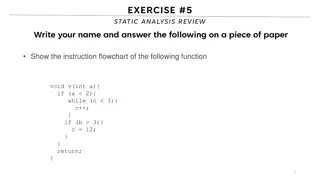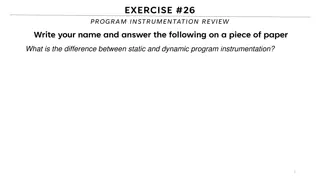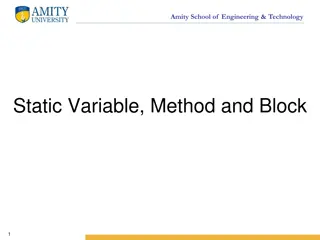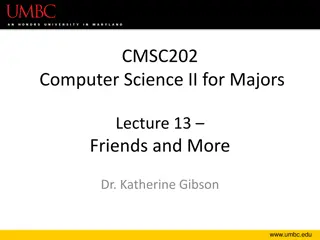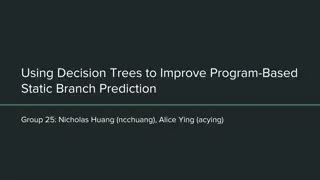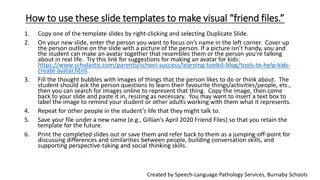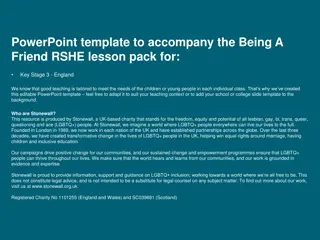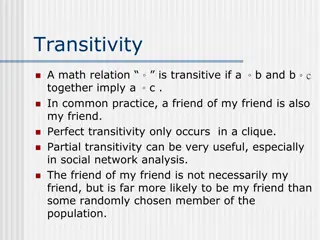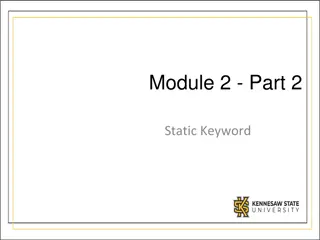Static and Friend
Create a DivSales class to track sales data for different divisions within a corporation. The class includes functions to store sales data, calculate yearly totals, and display sales information. Implement a program that utilizes the DivSales class to input and display sales data effectively
Download Presentation

Please find below an Image/Link to download the presentation.
The content on the website is provided AS IS for your information and personal use only. It may not be sold, licensed, or shared on other websites without obtaining consent from the author.If you encounter any issues during the download, it is possible that the publisher has removed the file from their server.
You are allowed to download the files provided on this website for personal or commercial use, subject to the condition that they are used lawfully. All files are the property of their respective owners.
The content on the website is provided AS IS for your information and personal use only. It may not be sold, licensed, or shared on other websites without obtaining consent from the author.
E N D
Presentation Transcript
Student using static class student { int id; string name; public: static int st_num; void main() { student s1( 1, ali ); cout<< student:: st_num <<endl; student(int id, string name) { st_num++; this->id= id; this->name= name; } }; student s2 ( 5 , ahmed ); cout<< student:: st_num <<endl; student s3( 3, mohamed ); cout<< student:: st_num <<endl; } int student :: st_num=0;
Student using static (cont.) class student { int id; string name; static int st_num; public: student(int id, string name) { st_num++; this->id= id; this->name= name; } static int getStNum() { return st_num; } }; // end of student class int student :: st_num=0; void main() { student s1( 1, ali ); cout<< student:: getStNum() <<endl; student s2( 2 , ahmed ); cout<< student:: getStNum() <<endl; student s3( 3, mohamed ); cout<< student:: getStNum() <<endl; }
Exercise 1 A corporation has three divisions, each responsible for sales to different geographic locations. Design a DivSales class that keeps sales data for a division, with the following data members: first_half, second_half, and static variable total_sales The class also contains the following member functions: A member function that takes two arguments, each assumed to be the sales for a half. The value of the arguments should be copied into the variables hold the sales data. The total of the two arguments should be added to the static variable that holds the total yearly corporate sales. Write a program that creates an array of three DivSales objects. The program should ask the user to enter the sales for the two half for each division. After the data are entered, the program should display a table showing the division sales for each half. The program should then display the total corporate sales for the year.
Friend Function A friend is a way to contain similar methods and ideas that are outside the scope of the original class, but are reliant on that class data. The declaration of friend function should be made inside the body of class (can be anywhere inside class either in private or public section) starting with keyword friend.
Example Single friend function class Battery{ int minPER, recentPER, temp; void swapEmergency(Battery & s1) { if( s1.recentPER < s1.minPER ) s1.recentPER = s1.temp; } public: Battery( int minPER , int recentPER) { temp= 20; this-> minPER = minPER; this-> recentPER = recentPER; } void main() { Battery b1; swapEmergency ( b1 ); cout << b1.getRecentPER( ) ; } // do set and get for minPER, recentPER friend void swapEmergency(Battery&); };
Friend Function Non-member function. Have access to private members of a class. Friend to more than one class. Class gives the permission of friend not the function.
Example using member function class square { int side; public: square(int a) { side = a; } class rect { int width, height; public: rect (int a, int b) { width = a; height = b; } int rArea() { return ( width * height ); } }; int sArea() { return ( side * side ); } };
Example (cont.) int addArea (square s, rect r) { return ( s.sArea() + r.rArea() ); } void main() { square sq(5); rect cout << addArea( sq , rec) <<endl; } rec(3,5);
Example using set & get class square { int side; public: square(int a) { side = a; } int getSide() { return side; } }; class rect { int width, height; public: rect (int a, int b) { width = a; height = b; } int getWidth() { return width; } int getHeight() { return height; } };
Example using set & get (cont.) int addArea (square s, rect r) { return ( s.getSide() * s.getSide() + r.getWidth() * r.getHeight() ); } void main() { square sq(5); rect cout << addArea( sq , rec) <<endl; } rec(3,5);
Friend Function This situation arises mostly in case of operator overloading. When you want to compare two private data members of two different classes. In that case you create a normal function and make friend in both the classes, as to provide access of theirs private variables.
Example using multiple friend class rect; class rect { int width, height; public: rect (int a, int b) { width = a; height = b; } friend int addArea(square s, rect r); }; class square { int side; public: square(int a) { side = a; } friend int addArea(square s, rect r); };
Example using multiple friend (cont.) int addArea (square s, rect r) { return ( s.side * s.side + r.width * r.height ); } void main() { square sq(5); rect cout << addArea( sq , rec) <<endl; } rec(3,5);
Exercises 2 Use operator overloading instead of addArea. friend int operator+ (square s, rect r)
Exercises 3 Find the largest area of rectangle or square and print it using friend function. friend void largest (square s, rect r)
Friend Class class Storage { private: double m_dValue; public: Storage(double dValue) { m_dValue = dValue; } friend class Display; }; class Display { private: bool m_display; public: Display(bool display) { m_display = display; } void displayItem(Storage storage) { if(m_display) cout << storage.m_dValue << endl; } void main() { Storage st(5, 6.7); Display dis(true); }; dis.displayItem(st); }



